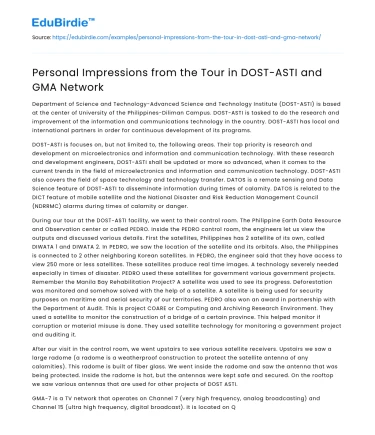Introduction
The dynamic landscapes of science, technology, and media play pivotal roles in shaping modern society. Visiting institutions like the Department of Science and Technology's Advanced Science and Technology Institute (DOST-ASTI) and GMA Network offers invaluable insights into how these sectors operate and innovate. DOST-ASTI is a leading research and development agency in the Philippines, focusing on information and communication technology and other scientific endeavors. Meanwhile, GMA Network is a major television and radio network, significant in the nation's media landscape. This essay explores my personal impressions from tours of these institutions, examining their contributions to technological advancement and media dissemination, and reflecting on the broader implications of their work. Through these visits, one gains a deeper understanding of the intricate interplay between technology and media and how they collectively influence public perception and societal development.
Exploring Technological Frontiers at DOST-ASTI
The tour of DOST-ASTI was an eye-opening experience, revealing the cutting-edge research and technological innovations being developed within the institution. DOST-ASTI plays a crucial role in the Philippines' scientific community, focusing on initiatives that range from satellite technology to computational research. One of the most striking aspects of the visit was the facility's emphasis on satellite technology, particularly the Diwata microsatellite program. As noted by a DOST-ASTI scientist, "Diwata-1 and its successors are designed to enhance environmental monitoring and disaster response" (DOST-ASTI 2020). This initiative underscores the potential of satellite technology in addressing the unique challenges faced by an archipelagic nation vulnerable to natural disasters.
Save your time!
We can take care of your essay
- Proper editing and formatting
- Free revision, title page, and bibliography
- Flexible prices and money-back guarantee
The visit also highlighted the collaborative nature of scientific research. DOST-ASTI's partnerships with both local and international institutions emphasize the global nature of technological progress. The facility's engagement in projects such as the Philippine Earth Data Resource and Observation (PEDRO) Center demonstrates its commitment to providing valuable data for various applications, from agriculture to urban planning. However, one cannot overlook the challenges faced by DOST-ASTI, such as funding constraints and the need for more skilled personnel to keep pace with rapidly advancing technologies. Addressing these challenges is crucial for sustaining the institution's contributions to national development.
Transitioning from DOST-ASTI's focus on cutting-edge science, the visit to GMA Network provided an equally compelling look into the world of media. While DOST-ASTI represents the pinnacle of technological innovation, GMA Network illustrates the power of media in shaping public discourse. Despite the different focal points, both institutions highlight the importance of effective communication and innovation in their respective fields.
Media Dynamics at GMA Network
At GMA Network, the tour delved into the inner workings of a major media organization, showcasing the complexity and reach of its operations. As one of the leading television and radio networks in the Philippines, GMA Network plays a significant role in informing and entertaining the public. The visit provided insights into the fast-paced environment of news production and the rigorous processes involved in ensuring accurate and timely dissemination of information. A GMA Network executive stated, "Our mission is to deliver unbiased news and high-quality entertainment that resonate with our audience" (GMA Network 2023).
GMA Network's commitment to journalistic integrity and innovation was evident in their state-of-the-art facilities and their adoption of new technologies, such as digital broadcasting and online streaming platforms. These advancements enable the network to reach wider audiences and adapt to changing viewer preferences. However, the media landscape is not without its challenges. Issues of misinformation and the pressure to maintain high ratings in a competitive environment pose significant hurdles. The network's strategies to combat these issues, such as fact-checking partnerships and audience engagement initiatives, are commendable efforts to uphold media standards.
The visit to GMA Network also sparked reflections on the ethical responsibilities of media organizations. In an era where information is abundant and easily accessible, the role of media in shaping societal narratives becomes even more critical. Balancing the need for sensational content with the responsibility of delivering factual information remains a delicate task. This reflection ties back to DOST-ASTI's mission of providing accurate data for informed decision-making, highlighting a shared commitment to truth and transparency between the two institutions.
Conclusion
In conclusion, the tours of DOST-ASTI and GMA Network offered profound insights into the roles of technology and media in contemporary society. DOST-ASTI's focus on scientific innovation and collaborative research demonstrates its vital contribution to national development and resilience. Meanwhile, GMA Network's commitment to journalistic integrity and technological adaptation underscores the influence of media in shaping public perception. Both institutions, despite their distinct focuses, share a common goal of advancing knowledge and understanding through effective communication and innovation.
These visits not only enhanced my appreciation for the complexities of technological and media landscapes but also highlighted the challenges they face in a rapidly changing world. Addressing issues such as funding limitations and misinformation requires collaborative efforts and a commitment to ethical standards. Ultimately, the experiences at DOST-ASTI and GMA Network serve as a reminder of the critical roles these sectors play in shaping the future, encouraging continuous exploration and dialogue between science, technology, and media.






 Stuck on your essay?
Stuck on your essay?

